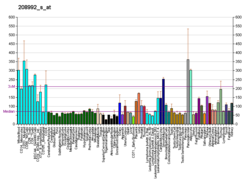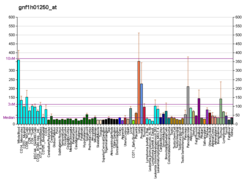STAT3
پروتئین ۳ ترارسانندهٔ پیام و فعالکنندهٔ رونویسی (انگلیسی: Signal transducer and activator of transcription 3) یک فاکتور رونویسی است که در انسان توسط ژن «STAT3» کُدگذاری میشود.[۴] این پروتئین یکی از اعضای خانوادهٔ بزرگ پروتئینهای STAT است.
وجود پروتئین STAT3 برای تمایز سلول ۱۷ تی کمکی (که در بروز تعدادی از بیماریهای خودایمنی نقش دارد)[۵] ضروری است و با برخی پروتئینهای دیگر همچون گیرنده فاکتور رشد اپیدرمی[۶][۷] و گیرنده آندروژن[۸][۹] تعامل پروتئین-پروتئین دارد.
بهنظر میرسد داروی نیکلوزاماید، مسیر سیگنالدهی پروتئین STAT3 را مهار میکند.[۱۰]
اهمیت بالینی
ویرایشجهشهای کارکردزُدا (Loss-of-function mutations) در این ژن، سبب بروز «سندرم هایپرایمونوگلوبولین E» میشود که فرد مبتلا طی آن، دچار عفونتهای مکرر و اختلالات استخوانی میگردد.[۱۱]
جهشهای کارکردزا (Gain-of-function mutations) در این ژن باعث ابتلای زودرس به بیماریهای ایمنی در چندین ارگان بدن میشود مانند ابتلای همزمان به دیابت، بیماری تیروئید، التهاب روده و کاهش گلبولهای خون.[۱۲]
فعالشدگی این ژن در چندین نوع سرطان، دلیلی بر پیشآگهی بد آنها خواهد بود.[۱۳][۱۴][۱۵][۱۶] پروتئین حاصله از این ژن، خواص ضد آپوپتوز و خاصیت تحریککنندگی برای رشد دارد.[۱۳]
جالب آنکه خواص سرکوبکننده تومور هم برای این ژن توصیف شدهاست.[۱۷][۱۸][۱۹] به عنوان مثال در گلیوبلاستوما که نوعی تومور مغزی است، بر حسب آنکه کدام بخش از ژن دچار جهش شده، ممکن است نقش تحریککننده یا سرکوبکننده تومور را ایفا کند.
منابع
ویرایش- ↑ ۱٫۰ ۱٫۱ ۱٫۲ GRCm38: Ensembl release 89: ENSMUSG00000004040 - Ensembl, May 2017
- ↑ "Human PubMed Reference:". National Center for Biotechnology Information, U.S. National Library of Medicine.
- ↑ "Mouse PubMed Reference:". National Center for Biotechnology Information, U.S. National Library of Medicine.
- ↑ Akira S, Nishio Y, Inoue M, Wang XJ, Wei S, Matsusaka T, Yoshida K, Sudo T, Naruto M, Kishimoto T (April 1994). "Molecular cloning of APRF, a novel IFN-stimulated gene factor 3 p91-related transcription factor involved in the gp130-mediated signaling pathway". Cell. 77 (1): 63–71. doi:10.1016/0092-8674(94)90235-6. PMID 7512451.
- ↑ Yang XO, Panopoulos AD, Nurieva R, Chang SH, Wang D, Watowich SS, Dong C (March 2007). "STAT3 regulates cytokine-mediated generation of inflammatory helper T cells". The Journal of Biological Chemistry. 282 (13): 9358–63. doi:10.1074/jbc.C600321200. PMID 17277312.
- ↑ Yuan ZL, Guan YJ, Wang L, Wei W, Kane AB, Chin YE (November 2004). "Central role of the threonine residue within the p+1 loop of receptor tyrosine kinase in STAT3 constitutive phosphorylation in metastatic cancer cells". Molecular and Cellular Biology. 24 (21): 9390–400. doi:10.1128/MCB.24.21.9390-9400.2004. PMC 522220. PMID 15485908.
- ↑ Olayioye MA, Beuvink I, Horsch K, Daly JM, Hynes NE (June 1999). "ErbB receptor-induced activation of stat transcription factors is mediated by Src tyrosine kinases". The Journal of Biological Chemistry. 274 (24): 17209–18. doi:10.1074/jbc.274.24.17209. PMID 10358079.
- ↑ Ueda T, Bruchovsky N, Sadar MD (March 2002). "Activation of the androgen receptor N-terminal domain by interleukin-6 via MAPK and STAT3 signal transduction pathways". The Journal of Biological Chemistry. 277 (9): 7076–85. doi:10.1074/jbc.M108255200. PMID 11751884.
- ↑ Matsuda T, Junicho A, Yamamoto T, Kishi H, Korkmaz K, Saatcioglu F, Fuse H, Muraguchi A (April 2001). "Cross-talk between signal transducer and activator of transcription 3 and androgen receptor signaling in prostate carcinoma cells". Biochemical and Biophysical Research Communications. 283 (1): 179–87. doi:10.1006/bbrc.2001.4758. PMID 11322786.
- ↑ Ren X, Duan L, He Q, Zhang Z, Zhou Y, Wu D, Pan J, Pei D, Ding K (2010). "Identification of Niclosamide as a New Small-Molecule Inhibitor of the STAT3 Signaling Pathway". ACS Medicinal Chemistry Letters. 1 (9): 454–9. doi:10.1021/ml100146z. PMC 4007964. PMID 24900231.
- ↑ Levy DE, Loomis CA (October 2007). "STAT3 signaling and the hyper-IgE syndrome". The New England Journal of Medicine. 357 (16): 1655–8. doi:10.1056/NEJMe078197. PMID 17881746.
- ↑ Milner JD, Vogel TP, Forbes L, Ma CA, Stray-Pedersen A, Niemela JE, Lyons JJ, Engelhardt KR, Zhang Y, Topcagic N, Roberson ED, Matthews H, Verbsky JW, Dasu T, Vargas-Hernandez A, Varghese N, McClain KL, Karam LB, Nahmod K, Makedonas G, Mace EM, Sorte HS, Perminow G, Rao VK, O'Connell MP, Price S, Su HC, Butrick M, McElwee J, Hughes JD, Willet J, Swan D, Xu Y, Santibanez-Koref M, Slowik V, Dinwiddie DL, Ciaccio CE, Saunders CJ, Septer S, Kingsmore SF, White AJ, Cant AJ, Hambleton S, Cooper MA (January 2015). "Early-onset lymphoproliferation and autoimmunity caused by germline STAT3 gain-of-function mutations". Blood. 125 (4): 591–9. doi:10.1182/blood-2014-09-602763. PMC 4304103. PMID 25359994.
- ↑ ۱۳٫۰ ۱۳٫۱ Klampfer L (March 2006). "Signal transducers and activators of transcription (STATs): Novel targets of chemopreventive and chemotherapeutic drugs". Current Cancer Drug Targets. 6 (2): 107–21. doi:10.2174/156800906776056491. PMID 16529541.
- ↑ Alvarez JV, Greulich H, Sellers WR, Meyerson M, Frank DA (March 2006). "Signal transducer and activator of transcription 3 is required for the oncogenic effects of non-small-cell lung cancer-associated mutations of the epidermal growth factor receptor". Cancer Research. 66 (6): 3162–8. doi:10.1158/0008-5472.CAN-05-3757. PMID 16540667.
- ↑ Yin W, Cheepala S, Roberts JN, Syson-Chan K, DiGiovanni J, Clifford JL (April 2006). "Active Stat3 is required for survival of human squamous cell carcinoma cells in serum-free conditions". Molecular Cancer. 5 (1): 15. doi:10.1186/1476-4598-5-15. PMC 1502137. PMID 16603078.
- ↑ Kusaba T, Nakayama T, Yamazumi K, Yakata Y, Yoshizaki A, Inoue K, Nagayasu T, Sekine I (June 2006). "Activation of STAT3 is a marker of poor prognosis in human colorectal cancer". Oncology Reports. 15 (6): 1445–51. doi:10.3892/or.15.6.1445. PMID 16685378.
- ↑ de la Iglesia N, Konopka G, Puram SV, Chan JA, Bachoo RM, You MJ, Levy DE, Depinho RA, Bonni A (February 2008). "Identification of a PTEN-regulated STAT3 brain tumor suppressor pathway". Genes & Development. 22 (4): 449–62. doi:10.1101/gad.1606508. PMC 2238667. PMID 18258752.
- ↑ Lee J, Kim JC, Lee SE, Quinley C, Kim H, Herdman S, Corr M, Raz E (May 2012). "Signal transducer and activator of transcription 3 (STAT3) protein suppresses adenoma-to-carcinoma transition in Apcmin/+ mice via regulation of Snail-1 (SNAI) protein stability". The Journal of Biological Chemistry. 22. 287 (22): 18182–9. doi:10.1074/jbc.M111.328831. PMC 3365759. PMID 22496368.
- ↑ Musteanu M, Blaas L, Mair M, Schlederer M, Bilban M, Tauber S, Esterbauer H, Mueller M, Casanova E, Kenner L, Poli V, Eferl R (March 2010). "Stat3 is a negative regulator of intestinal tumor progression in Apc(Min) mice". Gastroenterology. 138 (3): 1003–11.e1–5. doi:10.1053/j.gastro.2009.11.049. PMID 19962983.
- مشارکتکنندگان ویکیپدیا. «STAT3». در دانشنامهٔ ویکیپدیای انگلیسی، بازبینیشده در ۱۱ مارس ۲۰۱۹.
پیوند به بیرون
ویرایش
برای مطالعهٔ بیشتر
ویرایش- Hoey T, Grusby MJ (1999). STATs as mediators of cytokine-induced responses. Advances in Immunology. Vol. 71. pp. 145–62. doi:10.1016/S0065-2776(08)60401-0. ISBN 978-0-12-022471-5. PMID 9917912.
- Kisseleva T, Bhattacharya S, Braunstein J, Schindler CW (February 2002). "Signaling through the JAK/STAT pathway, recent advances and future challenges". Gene. 285 (1–2): 1–24. doi:10.1016/S0378-1119(02)00398-0. PMID 12039028.
- Joseph AM, Kumar M, Mitra D (January 2005). "Nef: "necessary and enforcing factor" in HIV infection". Current HIV Research. 3 (1): 87–94. doi:10.2174/1570162052773013. PMID 15638726.
- Inghirami G, Chiarle R, Simmons WJ, Piva R, Schlessinger K, Levy DE (September 2005). "New and old functions of STAT3: a pivotal target for individualized treatment of cancer". Cell Cycle. 4 (9): 1131–3. doi:10.4161/cc.4.9.1985. PMID 16082218.
- Leeman RJ, Lui VW, Grandis JR (March 2006). "STAT3 as a therapeutic target in head and neck cancer". Expert Opinion on Biological Therapy. 6 (3): 231–41. doi:10.1517/14712598.6.3.231. PMID 16503733.
- Aggarwal BB, Sethi G, Ahn KS, Sandur SK, Pandey MK, Kunnumakkara AB, Sung B, Ichikawa H (December 2006). "Targeting signal-transducer-and-activator-of-transcription-3 for prevention and therapy of cancer: modern target but ancient solution". Annals of the New York Academy of Sciences. 1091: 151–69. doi:10.1196/annals.1378.063. PMID 17341611.





